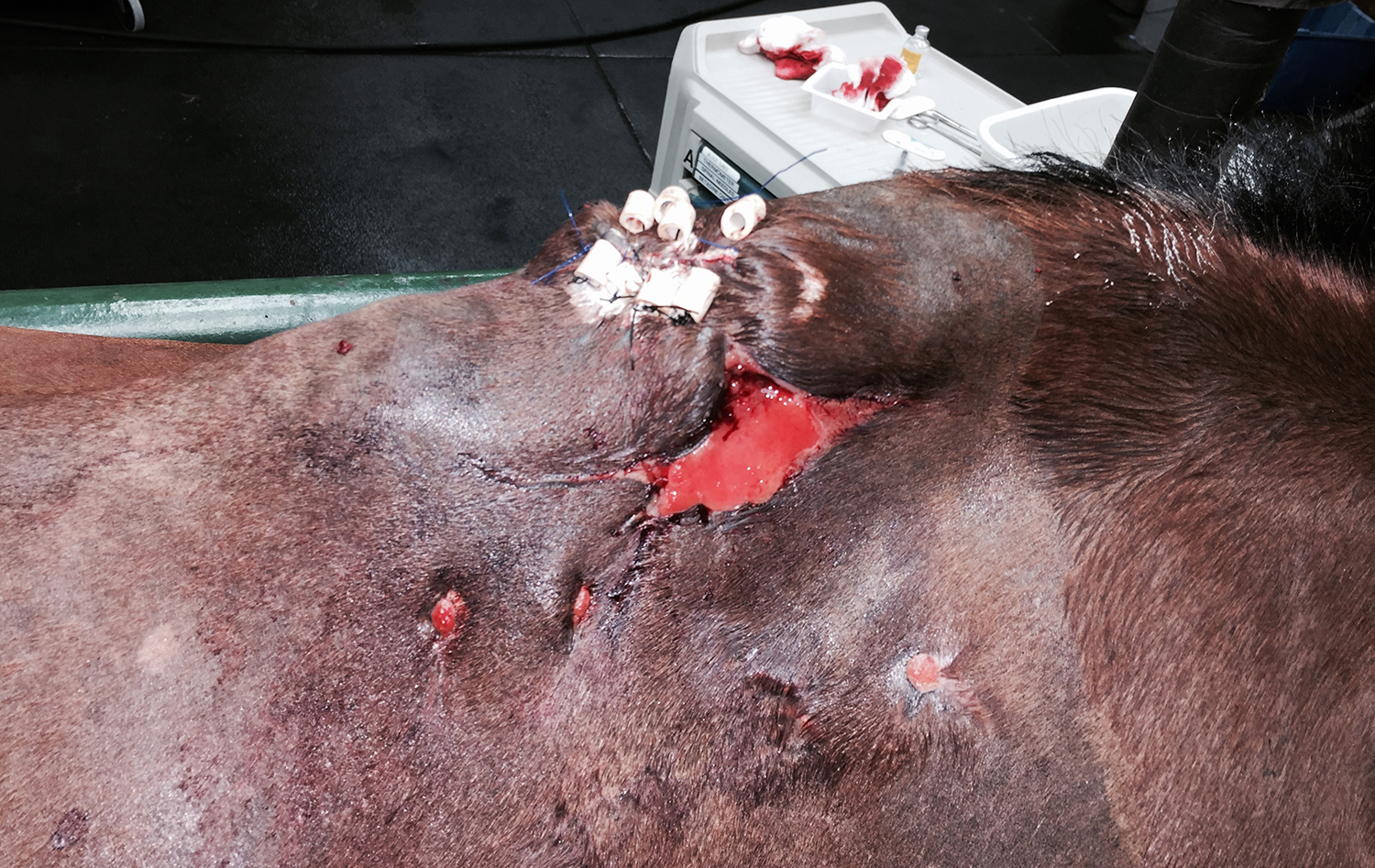People who have horses know that their horses are particularly prone to wounds. Small cuts that usually never amount to much are quite common. Larger, more serious wounds are fortunately less common but pose special problems specific to the equine species. Rarely, some equine wounds are spectacularly bad, career and even life threatening. The treatment and management of these wounds is the special realm of the equine veterinary practitioner.
We use a multitude of techniques to help mother nature optimize healing. Particularly difficult wounds involve the extremities from the knee (carpus) or hock (tarsus) and below. The most difficult wounds involve the fetlock and below. Immobilization techniques, supplemented by topical treatments to enhance local wound environments, are among the most helpful tools that we have. Systemic therapies and regenerative medicine techniques are also sometimes used including stem cells, platelet rich plasma, biologic and synthetic scaffold materials (template for new tissue growth), and wound vac (vacuum-assisted wound closure). Last, but definitely not least, in our extensive armory, is hyperbaric oxygen therapy (HBOT).

Hyperbaric oxygen therapy has revolutionized human healing especially in diabetes associated wound care. In addition, HBOT has dramatically changed the success rate for reconstruction of human radiation associated osteonecrosis (death of bone tissue). Crush injuries, such as those acquired in building collapse, earthquakes, and combat associated bombings often result in amputation of human limbs. HBOT has been proven extremely beneficial in avoiding amputation in many of these cases and is an active area of ongoing research in many areas, especially wounds.
Following the human example, equine wound management at the Equine Hyperbaric Center of South Florida uses hyperbaric oxygen treatment to manage some of the most challenging equine wounds.
A few words on the rationale for hyperbaric oxygen in wound healing.
Some, but not all, wounds are likely to benefit from hyperbaric oxygen. Wounds that have been found to benefit the most, not surprisingly, are wounds that lack sufficient oxygen. Normal tissue has a blood supply with red blood cells delivering oxygen to within micrometers of every cell. Wounded tissue, and especially severely crushed tissue, has compromised blood flow and therefore compromised red blood cell and oxygen delivery. Breathing pure oxygen under pressure (HBOT) causes oxygen to dissolve in plasma and tissue at far greater concentration than could ever be achieved by red blood cell hemoglobin delivery under normobaric (reduced oxygen) conditions. Oxygen delivery is essential for cell function and tissue repair. So, when wounding has disrupted blood delivery, hyperbaric oxygen can feed and resuscitate cells at great distances from healthy blood flow.
Nondescript wounds that fail to heal.
Some nondescript wounds that would normally be expected to heal with no management whatsoever occasionally fail to heal and become ugly. Most often this is due to habronema infestation (summer sores). Fly control for these is key but some horses are particularly susceptible to the development of these lesions. Once established, the lesions can be difficult to heal. We have found that HBOT gives good results in getting these wounds to rapidly heal using hyperbaric oxygen therapy.
Clients swear by hyperbaric oxygen as an important adjunct in healing some of the most difficult cases.
The fact is, body tissues need an adequate supply of oxygen to function. When tissue is damaged, it requires even more oxygen to survive. Hyperbaric Oxygen Therapy increases the level of oxygen in the blood carried to injured tissue. This increased level of oxygen helps the body prevent or fight infection by increasing white blood cell (attacks bacteria, viruses, and germs) function and is necessary for fibroblast (repair cells) production of collagen (main protein found in connective tissue) required for healing of wounds and damaged tissue.
If you have question or would like more information, please give us a call at 561-790-2226.
For examples of the use of HBOT in the treatment of wounds, please visit the Case History page.


